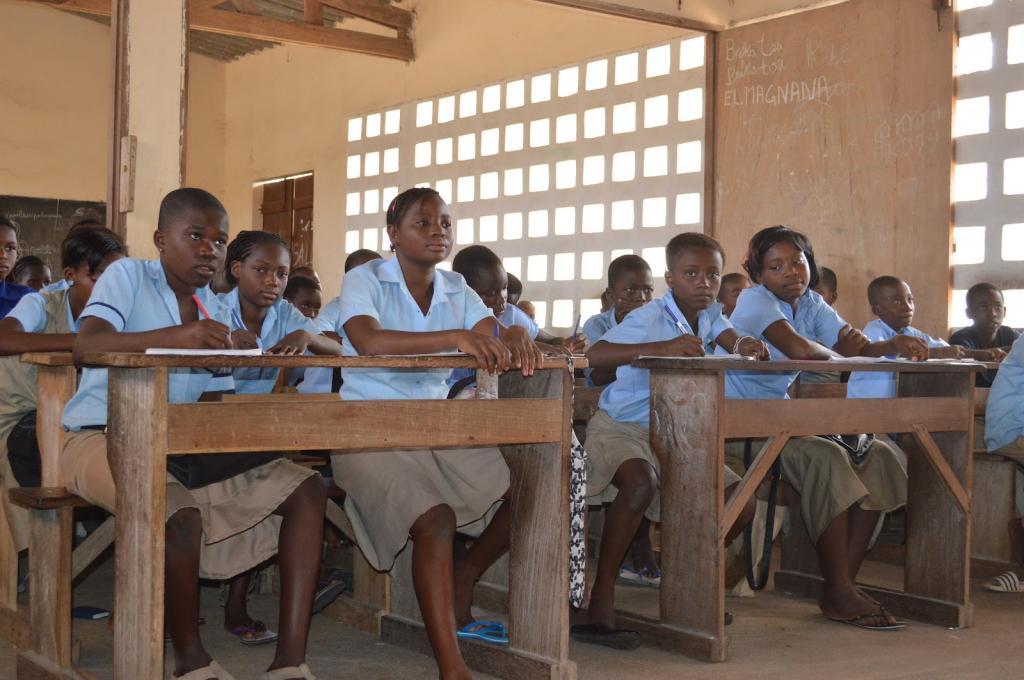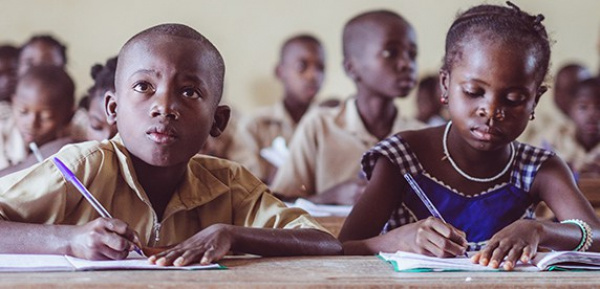1.0. INTRODUCTION
Education is an effective tool for poverty reduction and bridging the inequality gap in society. Moreover, spreading knowledge and sustainable economic growth can be achieved through education. Educated people are more likely to get access to employment opportunities, receive better income and enjoy life and contribute to national development. However, less educated people are limited to such opportunities. Educational system from primary education to the tertiary shapes human’s general, physical, psychological, moral, intellectual, and social development. formation. Good education is the guarantee of social progress, economic prosperity, family stability and other essential life elements. With population of about 8.0 million and 56,785sq km/21,925sqm. The literacy rate is 63.7% with 84.3% of them being youth and 78.4% consist of female youth.

Source: http:// www.jyapiasinafrica.blogspot.com.
2.0. EDUCATIONAL SYSTEM IN TOGO
The educational system of Togo is a French model type due to the colonization by the French. The first school establishment was by Akuété Zankli Lawson in 1842, when he came back from England. In the late 19th to beginning 20th century, the first schools for the essential needs of the administration and economic exploitation of the colonies were created. However, the educational system includes primary, secondary and higher levels. The people enjoy free education system at the primary level for the children at the age of six. The primary education in Togo increased from 26.29% to 44% between 1960 and 1970. The enrollment rate in primary education increased until 1980 (72%) then decline until 1985 (52%) and rise slowly then. In addition, secondary education follows the primary level and is offered for 12-year old children and consists of two cycles of four years for the first, and three years for the second cycle for a total of seven years.
The tertiary education offered in universities and other colleges have programs of study leading to baccalaureate and master’s degrees (Ministry of Education, Togo). Some of the famous tertiary institutions in Togo are the University of Lome established in 1970 with schools of humanities and sciences; the University Institute of Technology; and the University of Kara, which was founded in 1974 and offers various courses of study.

Source: https://www.graintec.com.
3.0 EDUCATIONAL STRUCTURE
3.1 Primary Education
Primary education which includes pre-primary for children entering at the age of three years, for a period of two years. Pre-primary education is not compulsory. Children enter primary school at the age of five for a period of six years. The certificate of graduation from primary education (CEPD) marks the end of primary school and provides access to middle school.
3.2. Junior Secondary
Junior Secondary Education (middle school) is four years. The certificate of graduation from junior secondary (BEPC) marks the end of this segment and allows students to access high school.
3.3. Senior Secondary Education
Senior secondary education (high school) runs three years for admitted students. At the end of the second year, students sit for an examination called the School-Leaving Certificate, part 1 (BAC1 or “Probatoire” in French). This certificate is required to access the terminal class (grade 12 in US system). This class concludes with the School-Leaving Certificate, part2 (BAC2=French Baccalaureate), which allow access to university education. The junior secondary and senior secondary education have two major streams: general or technical/ vocational education. Primary and secondary education each have three term totaling 40 weeks of teaching activities.
3.4. Institutes of Higher Education
Institute of Higher Education admit students of senior secondary education who passed the School-Leaving Certificate, part 2. This level of education includes studies in universities, specialized institutes of the government, and university education abroad. The studies vary between three and eight years. In higher education (university education), the academic year is divided into two semesters of 16 weeks each.
3.5 Free Access to Primary School
The partnership between United Nations International Children’s Fund (UNICEF) and the Togolese Government through local agencies has ensured free access to quality education by children at the primary level. The partnership continues to provide financial and technical support for the educational system in Togo. UNICEF partnership abolished school fees due to US$4 per day per child for school fees, which had impeded the goal of education for all. The education system in Togo is administered by three ministries including Primary and Secondary Education and Literacy, the Ministry of Technical Education and Vocational Training, and the Ministry of Higher Education.

Source: https://www.google.com/url.
4.0 CHALLENGES OF EDUCATION SYSTEM IN TOGO.
4.1. The High Poverty Level
The high poverty level in Togo is one of the fundamental factors that have affected the success of the global goal of “Education for All” (EFA). Free primary education has over the years increased the number of children going to school. The significant drop in completion and enrollment levels in high schools. The same goes for the number of students who successfully transition from high school to university. The inadequate funding saw a significant drop to a small portion of high school and university tuition fees. The rest is left for school management to find avenues to run the school, for instance, by requesting parents of the student to contribute money that proves to be unaffordable for most of them.
Although the education system in Togo has witnessed a dramatic change, there are major disparities in resources allocated to the schools. The high teacher-to-student ratio significantly affects the performance of both the teacher and the student, especially in primary and secondary schools. Most teachers tend to lose morale due to the overwhelming number of children in classes.
4.2. Poor Access to Technological Learning
Also, poor access to technological aids like laptops and e-books is pervasive due to lack of both electricity and internet connectivity.

Source: http://www.africanewsagency.com
4.3. Gender Disparity and equity issues in deprived and rural areas, low secondary schooling completion rates.
Gender display also plays a role in access to education in Togo. Early or premature marriages tend to force most girls out of school in Togo. Some communities view girls as a source of “income” and others are married off due to the patriarchal values that govern their communities. Such cases of female genital mutilation go in tandem with early marriages. However, the government and other nonprofit organizations are trying to curb this challenge yet persist in the system.
The government has continued to commit to developing effective education strategies and to solve the above challenges. The progress of Togo’s education system entails addressing several challenges. These include low access and equity issues in deprived and rural areas, low secondary schooling completion rates, and low literacy program coverage. The government’s education strategy 2014-2025 focuses on four key strategies: (i) develop a quality basic education to achieve universal primary education by 2022, (ii) extend preschool coverage in rural and poorer environment, (iii) develop the second cycle of quality secondary, technical, vocational, and higher education courses, and (iv) reduce the illiteracy rate.
The plan spells out four objectives to achieve these strategies:
v Correcting national disparities through attaining universal primary education, increasing completion rates at the primary and junior high levels, and developing a second cycle of secondary education, technical and vocational training, and higher education that aligns with job market needs
v Improving the effectiveness and quality of education services by improving internal efficiency. Developing effective partnerships by opening up dialogue with civil society, involving unions and communities in the decision-making process, and increasing parent participation in school management.
v Improving the management and governance of the education system by implementing a reliable information system, decentralizing management, and increasing accountability and transparency.
5.0. FUNDINGS OF EDUCATION SECTOR IN THE MIDST COVID-19 IN TOGO
According to the World Bank Report 2020, COVID-19 pandemic has exacerbated the learning crisis and resulted in a number of shocks to children, families and education systems this year. The impacts on the human capital of this generation of learners is likely to be long-lasting. Globally, 94 percent of students were out of school due to the pandemic. The country Togo was also affected and the educational system encountered several challenges.
The World Bank is part of a consortium with UNESCO and UNICEF implementing a $25 million grant from the Global Partnership for Education (GPE) for “Continuous and Accelerated Learning in Response to COVID-19”. The grant’s main goal is to keep children learning by supporting the development, dissemination and delivery of new and existing learning continuity interventions, at scale. Togo benefited from this kind of support from UNESCO AND UNICEF. There are five main lines of work led by the World Bank:
i) EdTech to support remote and accelerated learning, which will develop a toolkit to guide policymakers on implementing remote learning (including knowledge packs focused on delivery of instruction though various modalities such as radio and TV) and a study on the effectiveness of remote learning across more than 10 countries;
ii) Remote Formative Assessment solutions, which includes the design and piloting of formative assessment strategies by using basic phone technologies to support learning outside of physical classrooms. As part of this work, a tool is being developed that will help countries evaluate the feasibility of implementing phone-based (basic, non-smart-phone) formative assessment (through SMS/text, live connection to teachers (for example, virtual call centers), and interactive voice response (IVR) in the context of school closures;
iii) Read@Home, which will develop learning packages (books and other materials) to get into homes at a massive scale in 14 countries, engage parents to read with children at home, and use innovative approaches to deliver and procure books;
iv) Compendium of Lesson Plans, which includes developing a library of lesson plans and tools to improve early grade reading instruction in three pilot countries; and,
v) Technology for Teaching (T4T), which will identify scalable low-and-high-tech solutions for teacher professional development that can be replicated at scale, develop a tech-based professional development program to be implemented in two or three countries, and generate global public goods such as an online repository to support practitioners, researchers, and policymakers (World Bank Report 2020).

Source: https://www.worldbank.org.
The Covid Response allocated US$7 million into the education system from the World Bank (2020-2021). The US$7 million COVID-19 grant supports the education system through supporting distance learning and providing support to teachers, parents and caregivers (through TV and radio learning contents, online/offline platforms; teacher training; printed materials; communication campaigns for parents to support children’s learning at home and for sensitization on gender-related issues).
Another support is safe re-opening and re-entry to schools through WASH support for students and teachers (hand-washing devices; masks; school disinfections; codes of conduct for disease prevention; disease prevention campaigns through radio)
Provision of salary subsidies for volunteer teachers and remedial programs for at-risk students and back-to-school campaigns (radio, TV, printed materials) has been another covid response measure.
Moreover, distance learning approach to accommodate students with disabilities so that lessons broadcasted via television have sign language, and braille printed materials are distributed to students with impaired vision. Finally, girls were targeted in back-to-school campaigns, including sensitization programs on early marriage, gender-based violence, early pregnancies and the importance of continuing to learn in Togo.
Further, in late March 2020, the UNICEF office in Togo received a GPE grant of US$70,000 to support the Ministry of Education with planning its response to the pandemic. The grant is used to procure computers and other equipment for the ministry’s crisis management team conduct a rapid risk analysis support the design and broadcast of distance learning content aligned to the national curriculum.
(Bruce Emmanuel,Assistant Researcher of CWAS,School of Management and Economics of UESTC)
Please refer to the Chinese Version published on Huanqiu.com, one of the top three rating news media in China. Huanqiu.com is a national rating on line media platform, approved by the publisher of People's Daily and the Central Internet Information Office of China. This column is to provide a platform for researchers and practitioners on West African issues.

Link:https://opinion.huanqiu.com/article/434707UC2br